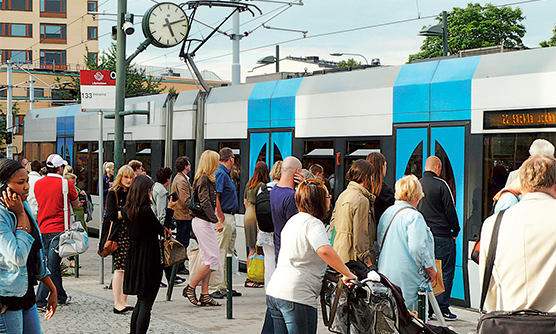Press release 2015-06-15 at 13:04

In Stockholm the orbital light rail line Tvärbanan circles around the inner city. © Panu Söderström
SYKE's press release on June 15th 2015
A recent study on the metropolitan areas of Helsinki and Stockholm indicates that the urban form in the two regions has developed partially in different directions during the past 20 years. Stockholm has managed to channel the growth of the metropolitan area more inwards, densifying the inner areas of the city region. In the Helsinki region, growth has occurred during the 2000s mainly in the peri-urban areas and the suburban car dependent zones.
“In Helsinki, the new phase of expansion in the inner city did not properly take off until 2008, when the new harbour released the old inner city harbour areas for new land-uses", researcher Panu Söderström explains. "In Stockholm the orbital light rail line Tvärbanan has boosted the growth around the inner city since 2000 and the old industrial areas have been transforming to new housing and workplace areas", he continues.
Helsinki needs rail-based polycentricity and regional land use guidance
Urban form in the Helsinki region has become more sprawled than in the Stockholm region during the 2000s. In international comparison, commuting distances in the Helsinki region correspond to those of significantly larger metropolitan areas. In order to develop the Helsinki Metropolitan Area, the researchers recommend decision-making at the metropolitan level, increasing the efficiency of infill development and supporting rail-based polycentricity.
“Decision-making regarding the control of metropolitan-level urban form has been slow and ambiguous in the Helsinki region, which makes it harder to predict the development of the area”, Professor Harry Schulman of the University of Helsinki estimates.” In Stockholm, the County Council coordinates community and traffic planning, forminga strong regional administration for the Stockholm region.
In Helsinki, polycentricity has, so far, increased in terms of housing, but the same is yet to happen with regard to work places. “What we need is a common vision of the network of sub-centres and an efficient public transportation network to link the various centres”, Senior Research Scientist Mika Ristimäki of the Finnish Environment Institute says. “In addition, we need to develop and implement new financial instruments to finance future growth at key locations”, he continues.
Summary report available in English
The Finnish Environment Institute has published an updated summary report in English based on the original book published last year. The framework of the study is connected to the theory of three urban fabrics (walking city, transit city, car city), the Urban Zone framework and related database development in SYKE. The study was implemented as a cooperative effort between the Finnish Environment Institute's built environment and land use research and the Department of Geosciences and Geography at the University of Helsinki. The project is part of the Helsinki Metropolitan Region Urban Research Program.
The report is available at: http://hdl.handle.net/10138/155224
More information
Senior Research Scientist Mika Ristimäki
Finnish Environment Institute SYKE
tel. +358 295 251 567
forename.lastname@ymparisto.fi (lastname = ristimaki)
Researcher Panu Söderström
Aalto University (at present)
firstname.lastname@aalto.fi (lastname = soderstrom)
Professor Harry Schulman
University of Helsinki
firstname.lastname@helsinki.fi
Communications
Communication Specialist Matti Lindholm
Finnish Environment Institute SYKE
tel. +358 295 251 380
firstname.lastname@ymparisto.fi
Related links
Earlier press release connected with the study
Stockholm beats the Helsinki region in increasing the density of its urban form – researchers would promote polycentricity in Helsinki (SYKE on June 16th 2014)
Related projects
Urban Zones Applied in Planning (Urban Zone 3)
Interview with Mika Ristimäki